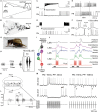Inhibitory Pathways for Processing the Temporal Structure of Sensory Signals in the Insect Brain
- PMID: 30186204
- PMCID: PMC6110935
- DOI: 10.3389/fpsyg.2018.01517
Inhibitory Pathways for Processing the Temporal Structure of Sensory Signals in the Insect Brain
Abstract
Insects have acquired excellent sensory information processing abilities in the process of evolution. In addition, insects have developed communication schemes based on the temporal patterns of specific sensory signals. For instance, male moths approach a female by detecting the spatiotemporal pattern of a pheromone plume released by the female. Male crickets attract a conspecific female as a mating partner using calling songs with species-specific temporal patterns. The dance communication of honeybees relies on a unique temporal pattern of vibration caused by wingbeats during the dance. Underlying these behaviors, neural circuits involving inhibitory connections play a critical common role in processing the exact timing of the signals in the primary sensory centers of the brain. Here, we discuss common mechanisms for processing the temporal patterns of sensory signals in the insect brain.
Keywords: cricket; disinhibition; duration coding; honeybee; moth; postinhibitory rebound; temporal structure; waggle dance.
Figures


References
-
- Baker T. C., Willis M. A., Haynes K. F., Phelan P. L. (1985). A pulsed cloud of pheromone elicits upwind flight in male moths. Physiol. Entomol. 10 257–265. 10.1111/j.1365-3032.1985.tb00045.x - DOI
Publication types
LinkOut - more resources
Full Text Sources
Other Literature Sources
Miscellaneous

